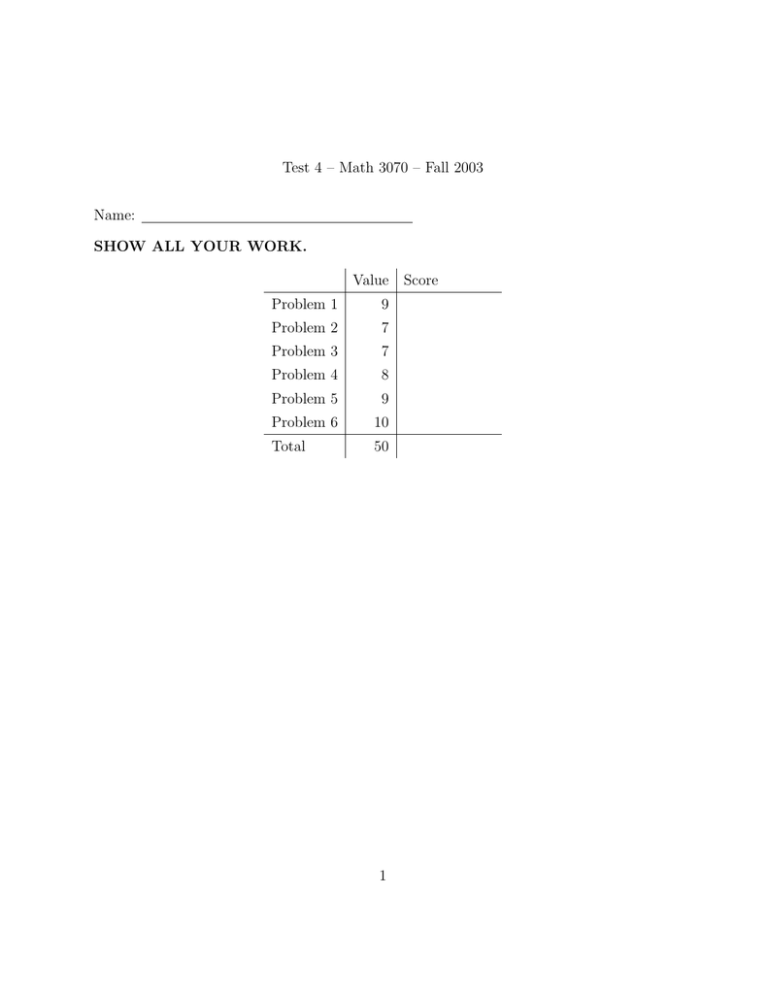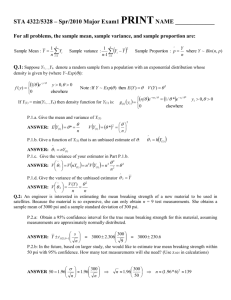Test 4 – Math 3070 – Fall 2003 Name: Value
advertisement

Test 4 – Math 3070 – Fall 2003
Name:
SHOW ALL YOUR WORK.
Value
Problem 1
9
Problem 2
7
Problem 3
7
Problem 4
8
Problem 5
9
Problem 6
10
Total
50
1
Score
Problem 1 (9 points). Let X1 , X2 be a random sample of size 2, from a distribution with
mean µ and variance σ 2 .
(a) (2 points) Suppose c is a constant satisfying 0 < c < 1. Is the estimator cX1 +(1−c)X2
unbiased for the population mean µ? Prove your answer.
(b) (4 points) What is the variance of cX1 + (1 − c)X2 ?
(c) (3 points) What value of c mimizes the variance of cX1 + (1 − c)X2 ?
Solution. We have
E(cX1 + (1 − c)X2 ) = cE(X1 ) + (1 − c)E(X2 ) = cµ + (1 − c)µ = µ(c + 1 − c) = µ ,
so cX1 + (1 − c)X2 is an unbiased estimator. Also,
V (cX1 + (1 − c)X2 ) = [c2 + (1 − c)2 ]σ 2 = [2c2 − 2c + 1]σ 2 .
Thus, to minimize variance, we need to minimize 2c2 − 2c + 1. Differentiating, setting
equal to zero, and solving for c gives c = 1/2. The second derivative is 4, so c = 1/2 is a
minimum.
2
Problem 2 (7 points). Let X1 , . . . , Xn be a random sample from the probability distribution with probability density function
1 e− λ1 x
f (x) = λ
0
if x ≥ 0
if x < 0 .
(a) (5 points) Derive the maximum likelihood estimator of λ. Hint: Recall that the joint
probability density for (X1 , . . . , Xn ) is f (x1 )f (x2 ) · · · f (xn ).
(b) (2 points) Is this estimator unbiased? Prove your answer. Hint:
R∞
0
1
x λ1 e− λ x dx = λ.
Solution. The joint density of X1 , . . . , Xn is
f (x1 , . . . , xn ; λ) =
n
Y
1 Pn
1 − 1 xi
e λ = λ−n e− λ i=1 xi .
λ
i=1
We want to maximize this as a function of λ. Taking logs gives
n
log f (x1 , . . . , xn ; λ) = −n log λ −
1X
xi .
λ i=1
Differentiating and setting equal to 0 gives
0=−
n
n
1 X
+ 2
xi
λ λ i=1
n
1X
= −λ +
xi .
n i=1
Solving yields λ = x̄. We must check that this is indeed a global maximum. We use the
second derivative test:
n
d2
n
2 X
log f (x1 , . . . , xn ; λ) = 2 − 3
xi
dλ2
λ
λ i=1
d2
n
2
log
f
(x
,
.
.
.
,
x
;
λ)
= 2 − 3 nx̄
1
n
2
dλ
x̄
x̄
λ=x̄
n
= − 2 < 0.
x̄
3
Thus x̄ is a local maximum. Checking that the function tends to −∞ as λ → 0 and λ → ∞
shows that x̄ is a global maximum. We conclude that the M.L.E. is λ̂ = X̄.
We have E(X̄) = E(X1 ) = λ, so this estimator is unbiased.
4
Problem 3 (7 points). Suppose that X1 , . . . , X10 is a random sample from a Normal
distribution. What is the probability that the random interval (X̄ − 0.58S, X̄ + 0.58S)
contains µ.
√
Solution. We know that X̄ ± St α2 ,9 / 10 is a (1 − α) × 100% confidence interval. so solving
t α ,9
0.58S = S √2
10
for t α2 ,10 yields
√
t α2 ,9 = 0.58 10 = 1.834 .
But the area to the right of 1.834 on the t-curve with 9 degrees of freedom is 0.05. Thus
α/2 = 0.05 and α = 0.1. Thus the coverage probability is 0.9.
5
Problem 4 (8 points). Suppose you want to estimate a proportion p in a large population,
based on a sample of size n and the sample proportion p̂. Assume that np > 50 and
n(1 − p) > 50.
(a) (2 points) What is the formula for an approximate 95% confidence interval for p?
(b) (6 points) What is the length of the interval you gave above? For what value of p̂ is
this interval the largest.
You would like this interval to be at most length 0.01. How big must n be so that this
interval is always, regardless of the value of p̂, no more than length 0.01?
Solution. We use the formula for an approximate 95% confidence interval
r
p̂(1 − p̂)
p̂ ± 1.96
n
The length of the interval is then
r
3.92
p̂(1 − p̂)
.
n
We note that p̂(1 − p̂) is maximized at p = 0.5, so it is never more than 0.25. Thus the
length of the interval is at most
√
1.96 n .
Solving 1.96n−1/2 = 0.01 for n yields n = 38416. That is for n ≥ 38416, the interval length
√
is guaranteed to be at most 1.96/ 38416 = 0.01.
6
Problem 5 (9 points). Let X1 , . . . , Xn be a random sample from a Uniform [0, θ] distribution:
f (x) =
1
if 0 ≤ x ≤ θ ,
0
if x < 0 or x > θ .
θ
(a) (1 point) Is X̄ an unbiased estimator of θ?
(b) (2 points) If not, find an unbiased estimator of θ based on the statistic X̄.
(c) (2 points) Compute the variance of the unbiased estimator you found in (b). Hint:
The variance of a Uniform(A, B) random variable is (B − A)2 /12.
(d) (3 points) Consider the statistic
θ̂ = max{X1 , X2 , . . . , Xn } .
We computed in class that θ̂ has probability density function
ntn−1
if 0 ≤ t ≤ θ ,
θn
fθ̂ (t) =
0
otherwise.
We furthermore saw that the statistic n+1
θ̂ is unbiased for θ. Compute the variance
n
n+1
of n θ̂.
(e) (1 point) Which is a better estimator, your answer in (b) or
n+1
n
θ̂? Justify your
answer.
Solution. We have E(X̄) = E(X1 ) = θ/2. Thus X̄ is not unbiased. But the estimator 2X̄
is unbiased.
We have
V (2X̄) = 4V (X̄) = 4
σ2
θ2 /12
3θ2
=4
=
.
n
n
n
We have
2
Zθ
E(θ̂ ) =
0
ntn−1
t2 n dt
θ
Zθ
=
ntn+1
ntn+2 θ
n 2
dt
=
=
θ
θn
(n + 2)θn 0 n + 2
0
7
Thus
i2
V (θ̂) = E(θ̂ ) − E(θ̂)
h
2
n 2
n2
θ −
θ2
n+2
(n + 1)2
n
=
θ2 .
(n + 2)(n + 1)2
=
Thus
V
n+1
θ̂
n
(n + 1)2
=
V (θ̂)
n2
(n + 1)2
n
θ2
=
2
n
(n + 2)(n + 1)2
1
=
θ2 .
n(n + 2)
8
Problem 6 (10 points). Say if each of the following answers is True or False. You must
include a short justification for each of your answers. Credit will not be given
without a justification. Each is worth 2 points.
(a) X̄ is always an unbiased estimator of the population mean.
(b) Suppose I take a sample of size 10 from a Normal distribution with variance 1 and find
√
that X̄ = 11. Then the probability that the confidence interval (11 − 1.96/ 10, 11 +
√
1.96/ 10) contains the population mean µ is 0.95.
(c) For any pair of random variables X and Y , and constants a and b,
V (aX + bY ) = a2 V (X) + b2 V (Y ) .
(d) Let p̂ be a sample proportion from a sample of size n. Then V (p̂) = np(1 − p), where
p is the population proportion.
(e) If X1 and X2 are independent and identically distributed, then always X1 + X2 is
approximately Normally distributed.
Solution. (a) Yes, E(X̄) = µ always, where µ is the population mean.
(b) No. The interval given is a fixed interval which either contains µ or doesn’t contain
it. The probability statement only applies to the random interval before the sample is
collected.
(c) No. This only holds for independent X and Y .
(d) No. V (p̂) = p(1 − p)/n.
(e) No. X1 + X2 + · · · + Xn is only approximately normal if n is large, or the Xi are close
to normal themselves.
9






